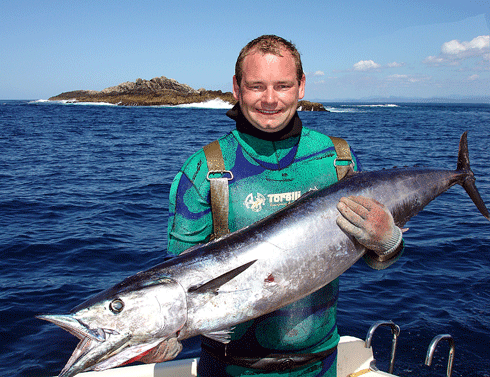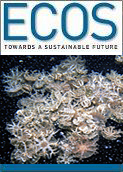
|
Published: 10 September 2012
Buddy diving to explore changing marine environment
Recreational fishing clubs and scientists will be better informed about the impacts of a changing climate on coastal fish species, thanks to a new partnership between the two groups.

|
|
Spearfisher Matthew Koopman near Coffs Harbour with a wahoo (Acanthocybium solandri), a pelagic species known to follow warmer waters southwards. Credit:
Matthew Koopman
|
Competition records collected by fishing clubs over the past 50 years will be used by CSIRO scientists in a new project which aims to detect changes to fish distributions along the south-east Australian coast in response to warming coastal waters.
CSIRO fish biologist, Daniel Gledhill, said he and his colleagues hope to understand how these changes will impact on the experience of recreational fishers and to better develop adaptation strategies for coastal communities.
‘As marine species and fishing communities adapt to climate change, fishers are facing increased challenges. Ensuring sustainable use and management of coastal waters is becoming increasingly complex,’ he said.
Scientists will review historic records from New South Wales, Victorian and Tasmanian fishing clubs from as early as the 1960s.
‘Long-term, statistically robust datasets of marine species are rarely available, so scientists are turning to novel, high-quality datasets such as those from spearfishing clubs to fill this knowledge gap. Spearfishing competition data sheets are a historical “biodiversity inventory” for recreational fish species,’ Mr Gledhill said.
‘Recreational users of coastal waters are often in the best position to see changes occurring locally. These records will provide us with a precious insight into how fish populations have moved as the East Australian Current (EAC) pushes southwards.
‘Geographic extensions of species ranges are already being recorded for recreationally targeted species in Australian waters.’
Coastal waters off the east coast of Tasmania are warming at 3–4 times the global average, largely resulting from the intensification of the EAC. These changes are bringing sub-tropical species to the state that have not been seen previously and are having detrimental impacts, for example, on endangered giant kelp forests and associated species.
Member of the Melbourne-based Southern Freedivers spearfishing club, Dr Matt Koopman, says changes in species are already being seen in Victoria.
‘There are a couple of species that have been caught in Port Phillip Bay in the past 10 years that I’d never heard of in coastal Victorian waters,’ Dr Koopman said.
In contrast, Underwater Skindivers & Fishermen's Association’s Mr Adrian Jeloudev said some New South Wales fishers have noticed ‘less movement of northern species down the central area of the NSW coastline compared to the previous decade’.
Examination of long-term data will allow these observations to be assessed in the context of short-term variability in the EAC as well as longer-term trends.
‘Previous studies suggest the 1980s was a tipping point for change among marine species on the east coast of Australia. Early records from the 60s and 70s will provide a baseline against which we can measure change and compare distributions against what is being recorded now,’ Mr Gledhill said.
Source: CSIRO



